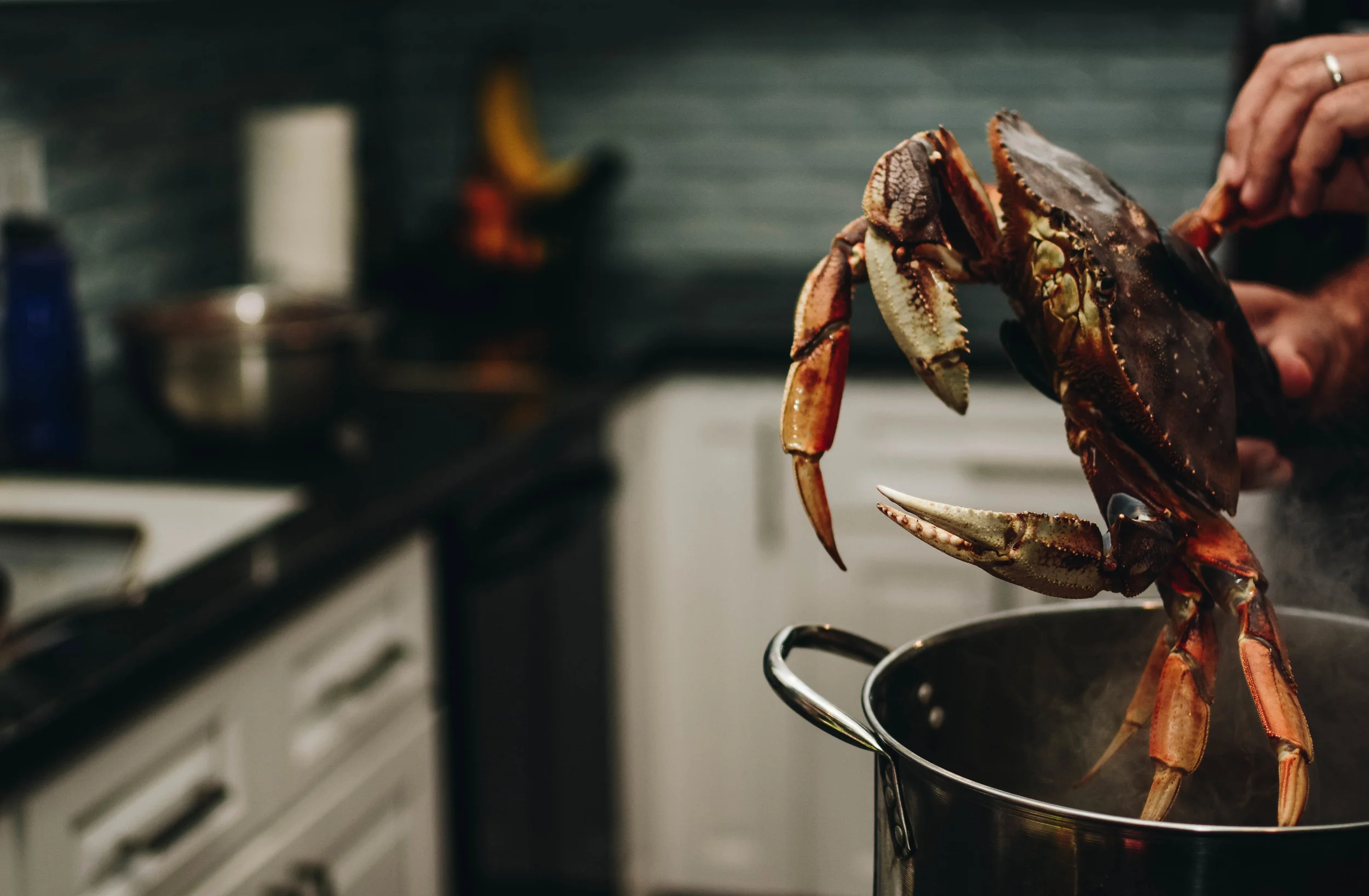PROCESSING WHOLE CRABS
Good crab meat is one of the best flavors I can imagine. It is sweet and salty, and reminiscent of clean sea water. It is truly special and can contribute a lot to a very elegant and interesting meal. It is a shame that most people have no idea what good crab even means. Crab deteriorates very quickly and is often served in a condition less than prime. Maybe I am particularly sensitive to the flavor, but substandard crab really kills my appetite. I rarely gamble on a crab dish outside of my home unless I am at a place that is renowned for good crab, or very near the ocean. I try to eat only local crab where possible. For Northern California, that means Dungeness crabs. Dungeness crabs are the subject of the below lesson. The techniques will also work with blue crabs, which is what I’d be eating if I lived in the gulf or the Northeast. If I lived in the Northwest, it would be king crab or snow crab.
The only way that I feel truly safe eating crab is when it is very fresh. For crabs, that means I buy it live and boil it myself. That ensures an almost 100% certainty of getting a perfect helping of crab meat. If you have to buy frozen crab, king crab is your safest bet. It can be pretty close to peak even after a few months in the freezer. Crabs require a little instruction and a lot of effort to work with. That effort will be rewarded with sweet crab meat, but first you have to procure some good crabs. That can be easier said than done.
Dungeness crab season begins in November most years and runs through the winter. Outside of the season, you can still buy live crabs, but I rarely see them anywhere outside of Asian grocery stores. These stores generally have large tanks that they keep stocked with crabs year-round. I will caution you though, the quality of these crabs stored in tanks can deteriorate. Summer crabs are not only very expensive, but also very lean. The yield will be much lower on summer crabs and the meat will be less creamy and less firm. I’ll buy them anyway when I start to get desperate for a good crab cake, but it can be hard on the wallet. Prices seem to peak in June at around $10.99/lb, which feels like a lot for low yield crabs that can be as cheap as $3.99 in the winter. In season, Dungeness crabs are much easier to come by. Many grocery chains will take orders for them either live or boiled, especially around Christmas time. Seafood stores or ocean-side Marinas are always your best bet. I usually ask for 2 big crabs. Make sure each crab has both claws as those are the meatiest part.
Blue crab season in the Northeast runs April to December most years. Along the gulf coast, they are often available year-round. Other crab species are generally sold boiled and frozen, so these are also available all year.
Boiling crabs is pretty straight forward. First, fill a large stock pot about 1/2 full of water and add 1/4 cup of coarse salt. If you plan to eat the crab meat by itself, you can substitute a spicier crab boil instead of salt. There are plenty of pre-packaged mixes out there. I like Zatarains. Otherwise, you can add things like black pepper, cayenne, and garlic powder. Make sure the water is low enough that the crabs can fit in the water without overflowing the pot, but high enough that they will be fully covered. You can give them a test dunk in cold water before you start if you are uncertain about the water level. I usually feel comfortable eyeballing it. With the crabs set aside, bring the water to a rapid boil. The heat should be as high as possible and the water should be really raging. The crabs are cold and they will drop the water temperature when they hit the water. Having the most water possible and an extremely rapid boil will ensure consistent cooking and a quick and humane death for the crabs. Drop the crabs in, making sure they fully submerge.
If you find yourself feeling bad for the little crabbies, consider this: crabs have been regularly observed to continue on with normal activities, even while sustaining serious injuries. If a crab has its leg ripped off, it will move away from a threat, but then generally resume eating or mating immediately. That is a good indicator that these animals don’t perceive pain in the way that we understand it. Still, I try to make it as quick as possible and the above method should get it done in just a few seconds. You may see some movement after the crab is dead as the leg muscles contract. You may also hear a high- pitched sound. Rest assured, that is not the death scream of a dying crab. It is pressure relieving through the joints in the exoskeleton as the crab’s internal temperature and pressure rises.
Crabs should boil for about 8 minutes per pound. That refers to the average weight per crab, not the total weight of crabs in the pot. For average Dungeness crabs, that means about 15 to 20 minutes. Blue crabs take 10-12 minutes. Other crab species or crab parts are usually pre-cooked, so you just need to warm them through. Once the time is up, I pull them off the heat, drain, and rinse once with cool water. If you leave them in water to cool slowly, they will take on water and this water will carry away some of that delicious flavor. If you plan to eat the crabs right away, just cool them enough to handle so you can eat the crab while it is still nice and warm. If you plan to make something like crab cakes or a crab melt, then you can really dump a bunch of water on them to cool them quickly so you can get to work.
Once the crabs are cool enough to handle, the real fun begins. I’ve tried crab crackers and hammers, and knives, but I’ve concluded that crab scissors are the only way to go. These are quick and don’t fling a bunch of crab bits all over your kitchen. Grasp the crab in your non-dominant hand as shown.
Break off all the legs and claws.
Break off the little flap on the bottom. This is a male crab. For females it would be wider, but female crabs are illegal to harvest in many places.
Remove the upper carapace. I do this before I get to work on the legs since it can hold a lot of hot liquid inside. Let it cool while you work the legs.
Cut off the point of each leg. Then insert the scissors into the end and split the shell lengthwise.
For heavier segments like the claws, use the cracker near the handles to gently break it apart.
For the bigger, harder leg segments cut the top and bottom of the shell.
The rest of the crab holds quite a bit of meat. It is a little messy and takes some work, but these are the biggest lumps of meat. First, remove everything that looks gross. There will be white or greenish colored tendrils that feel rough to the touch. These are the lungs and can just be pulled off by hand.
There is some yellow-colored fat that can be washed away with water along with the other membranes and assorted viscera.
Once these are rinsed off, the remaining piece will be a clean shell with multiple chambers of meat contained within the chambers. Break this in half width-wise by grasping in both hands and pulling down with your thumbs.
Then remove anything else that you expose that is not crab meat. Work through the chambers with a paring knife or scissors, taking care not to get any shells in your meat. These shells are fine and brittle, so it is easy to lose track of small pieces of shell, which will not go well with your teeth. Each crab is a bit different and you’ll have to move from one end to the other, cutting where it makes sense to release the crab in the largest possible chunks.
The final product should look like this. Now you are ready to eat it or make it into something really special. Consume within about 24 hours, otherwise it will start to sweat a milky liquid and lose quality.



















